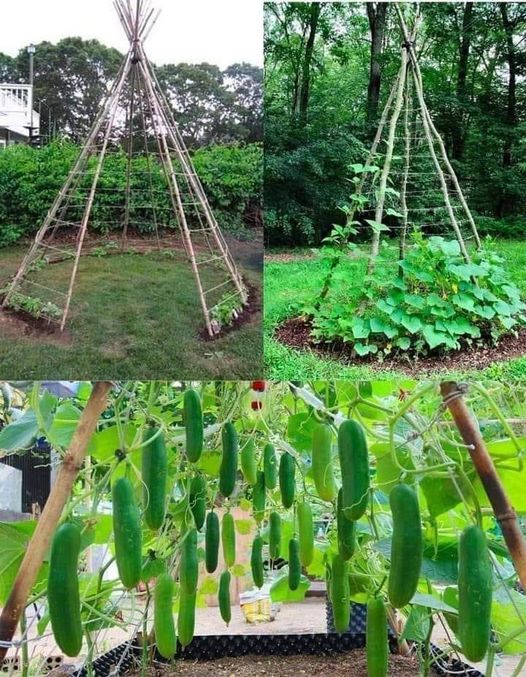Growing cucumbers in your garden can be a rewarding experience, but it often comes with challenges like space constraints, pest control, and ensuring your plants receive enough sunlight. The Herringbone Method, also known as vertical trellising, is an innovative and efficient way to grow cucumbers that addresses these challenges while also adding a rustic charm to your garden. By training your cucumber plants to grow vertically, you can maximize space, improve plant health, and increase your overall yield. In this comprehensive guide, we’ll walk you through everything you need to know about mastering the Herringbone Method for growing cucumbers.
Why Choose the Herringbone Method?
The Herringbone Method is an ideal solution for gardeners looking to optimize their space. Whether you have a small backyard garden or are working with a container garden on your patio, vertical growing allows you to cultivate more plants in less space. But the benefits don’t stop there:
- Improved Sunlight Exposure and Air Circulation:
Growing cucumbers vertically ensures that all parts of the plant receive adequate sunlight, which is essential for photosynthesis and fruit production. Additionally, vertical growing enhances air circulation around the plants, reducing the risk of fungal diseases and promoting overall plant health. - Easier Pest Management:
By elevating your cucumber plants, you make it more difficult for ground-dwelling pests to reach the vines. This can significantly reduce the need for chemical pest control and keep your plants safer from insects and other critters. - Simplified Harvesting:
When cucumbers are grown vertically, the fruits hang down from the trellis, making them easier to spot and pick. No more rummaging through dense foliage or missing out on cucumbers until they’re overripe. - Aesthetic Appeal:
The Herringbone Trellis adds a unique, rustic touch to your garden. The sight of cucumber vines gracefully climbing a beautifully constructed frame is not only functional but also visually pleasing.
Steps to Create Your Herringbone Trellis
Now that you understand the benefits of the Herringbone Method, let’s dive into the step-by-step process of creating your own herringbone trellis and growing cucumbers the vertical way.
1. Build the Frame
The first step in setting up your Herringbone Trellis is to build a sturdy frame. You’ll need bamboo poles, wooden stakes, or any strong material that can support the weight of mature cucumber vines. Arrange these poles in a teepee-like structure, with the tops tied together securely. Make sure the frame is tall enough—typically around 6-8 feet—to accommodate the full growth of the cucumber vines.
If you prefer a more elaborate design, you can create a herringbone pattern by attaching additional horizontal supports between the vertical poles. This not only adds strength to the trellis but also provides more climbing surfaces for the vines.
2. Plant Your Cucumbers
Once your frame is in place, it’s time to plant your cucumber seedlings. Position them around the base of the trellis, spacing them about 12-18 inches apart. Cucumbers thrive in well-draining soil, so ensure the planting area is rich in organic matter and has good drainage. Water the seedlings thoroughly after planting to help them establish strong roots.
3. Train the Vines
As your cucumber plants begin to grow, they’ll naturally start to send out tendrils, which they use to climb. Gently guide these tendrils toward the trellis, helping them wrap around the poles or supports. You can use soft plant ties or twine to secure the vines to the trellis if needed, but be careful not to tie them too tightly, as this can damage the stems.
Regularly check on your plants to ensure they’re continuing to climb the trellis as they grow. This will prevent the vines from sprawling along the ground, which can lead to overcrowding and increased susceptibility to pests and diseases.
Maintaining Your Herringbone Trellis and Plants
1. Watering and Fertilizing
Cucumbers need consistent moisture to thrive, especially when grown vertically. Water your plants deeply at least once a week, more often during hot, dry spells. Mulching around the base of the plants can help retain soil moisture and keep the roots cool.
Fertilizing is also important for promoting healthy growth and fruit production. Use a balanced fertilizer every 3-4 weeks during the growing season. If you prefer organic options, compost tea or a diluted fish emulsion works well for cucumbers.
2. Pruning and Maintenance
To encourage healthy growth and prevent overcrowding, prune your cucumber vines regularly. Remove any yellowing leaves, damaged stems, or excess growth that may be blocking sunlight from reaching other parts of the plant. Additionally, keep an eye out for pests like aphids or cucumber beetles, and address any infestations promptly to protect your crop.
3. Harvesting
One of the most satisfying aspects of growing cucumbers vertically is the ease of harvesting. As the cucumbers hang down from the trellis, they’re easy to see and reach. Harvest cucumbers when they’re firm, uniformly green, and before they grow too large. Regular harvesting encourages the plant to produce more fruit.
Conclusion: Elevate Your Gardening Game with the Herringbone Method
The Herringbone Method is a game-changer for cucumber growers, offering a space-efficient, aesthetically pleasing, and highly productive way to cultivate this beloved garden vegetable. By following the steps outlined above, you can build a beautiful herringbone trellis, train your cucumber vines to grow vertically, and enjoy a bountiful harvest throughout the growing season. Whether you’re a seasoned gardener or a beginner, this method is sure to elevate your gardening experience—literally and figuratively. Happy gardening! 🌿🥒🌿
